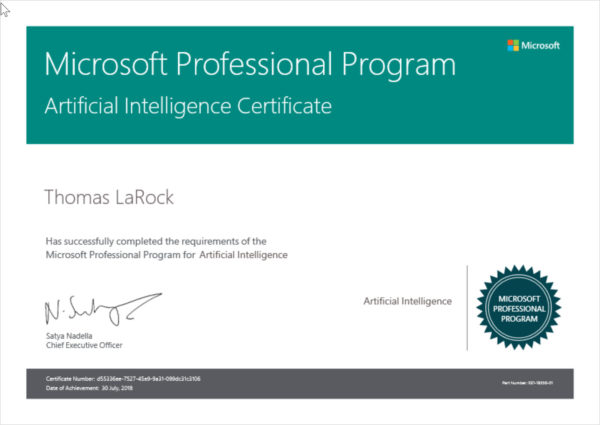Frequent readers of this blog may recall last year I earned a certificate in Data Science through the Microsoft Academy and edX. I followed up with a certificate in Big Data earlier this year. Today I am happy to tell you that I am now certified in Artificial Intelligence, giving me a Trifecta of Microsoft Academy certifications.
That makes three certificates in the past year. I’m not certain if I will look to do more certifications right now. I think I would rather use my free time to apply these new skills, and get some practical experience.
Microsoft Professional Program for Artificial Intelligence track
Here’s a list of courses needed to obtain the certificate:
Introduction to Artificial Intelligence (AI)
Introduction to Python for Data Science
Essential Math for Machine Learning: Python Edition
Ethics and Law in Data and Analytics
Data Science Research Methods: Python Edition
Principles of Machine Learning: Python Edition
Deep Learning Explained
Reinforcement Learning Explained
Natural Language Processing (NLP)
Microsoft Professional Capstone : Artificial Intelligence
The capstone project was frustrating, maddening at times, and one of the most rewarding projects I have ever completed. The project involved taking 20,000 images with labels, using them to build a predictive model, and then running that model against 20,000 test images and outputting the predicted label for each. A passing score was to have your model be about .9933 accurate. In other words, out of 20k images, you are allowed 134 incorrect. My score was .9997, which means my model had six incorrect. Yes, it still bothers me that I missed those six.
Some of the Lessons Learned
Compared to the first two certifications, there was a lot of new material this time around. That meant a lot of new learning, as well as the reinforcing of concepts from earlier courses. Here’s a summary list of the important items:
– The most time consuming part of any AI project is at the start, with data curation, consumption, and preparation taking up to 95% of your total time.
– There is no “right” number when it comes to things like epochs, batch sizes, layers, and percentage of data divided into train and test sets. You will build many models and adjust these parameters, looking to improve your model each time.
– But sometimes, the answer is really as simple as “Up the Epochs“.
– It’s easy to get Jupyter notebooks running locally, on Windows or MacOS, allowing a lot of functionality providing you have the right packages installed.
– Oh, and it’s easy to have 37 different versions of Python installed. When you are done with this course, you will be a master at debugging issues with Python and packages such as Keras, TensorFlow, and OpenCV2.
– VSCode is a great tool at editing and running Python scripts, too. I spent a lot of time in VSCode, but ultimately got my project done using local Jupyter notebooks.
– Before I forget, a quick shout out to Azure Notebooks, because they are useful for getting started with notebooks. They weren’t powerful enough for my final project needs, though, but I could not complain about the price (F-R-E-E).
– I used to ask why someone would use R versus Python. Well, now I know. R is a great tool, but Python seems to offer a lot more functionality and has a larger user base, which means you are going to find data science and AI examples written in Python more often than R. If I had to recommend one of them to learn, it would be Python.
– While your model is building you have time on your hands. It’s helpful to have some additional projects to get done, like building a firepit or maybe enjoying some good Scotch next to the fire in your new firepit.
Summary
I’ve written and talked on the subject of the changing role of DBAs and data professionals before, so I’m not going to do that again here today. If you aren’t on board with how this tech is evolving, then we are riding different trains. There’s nothing wrong with that. You do you, and I’ll do me.
But I love this stuff. And this stuff is the future. And the skills you develop in these programs are going to help make your job easier over time. If you don’t think you have time to do a course right now, that’s fine. But take another look at the list of classes available, and see if there might be one you are interested in learning more about.
Start there, with something that looks interesting, maybe even fun to try.
For me, I’m heading over to Kaggle, to try my hand at some of the projects and competitions they have. I want to keep my skills sharp, and they have the data to help.


